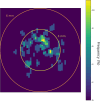Sequence of Morphological Changes Preceding Atrophy in Intermediate AMD Using Deep Learning
- PMID: 39028907
- PMCID: PMC11262471
- DOI: 10.1167/iovs.65.8.30
Sequence of Morphological Changes Preceding Atrophy in Intermediate AMD Using Deep Learning
Abstract
Purpose: Investigating the sequence of morphological changes preceding outer plexiform layer (OPL) subsidence, a marker preceding geographic atrophy, in intermediate AMD (iAMD) using high-precision artificial intelligence (AI) quantifications on optical coherence tomography imaging.
Methods: In this longitudinal observational study, individuals with bilateral iAMD participating in a multicenter clinical trial were screened for OPL subsidence and RPE and outer retinal atrophy. OPL subsidence was segmented on an A-scan basis in optical coherence tomography volumes, obtained 6-monthly with 36 months follow-up. AI-based quantification of photoreceptor (PR) and outer nuclear layer (ONL) thickness, drusen height and choroidal hypertransmission (HT) was performed. Changes were compared between topographic areas of OPL subsidence (AS), drusen (AD), and reference (AR).
Results: Of 280 eyes of 140 individuals, OPL subsidence occurred in 53 eyes from 43 individuals. Thirty-six eyes developed RPE and outer retinal atrophy subsequently. In the cohort of 53 eyes showing OPL subsidence, PR and ONL thicknesses were significantly decreased in AS compared with AD and AR 12 and 18 months before OPL subsidence occurred, respectively (PR: 20 µm vs. 23 µm and 27 µm [P < 0.009]; ONL, 84 µm vs. 94 µm and 98 µm [P < 0.008]). Accelerated thinning of PR (0.6 µm/month; P < 0.001) and ONL (0.8 µm/month; P < 0.001) was observed in AS compared with AD and AR. Concomitant drusen regression and hypertransmission increase at the occurrence of OPL subsidence underline the atrophic progress in areas affected by OPL subsidence.
Conclusions: PR and ONL thinning are early subclinical features associated with subsequent OPL subsidence, an indicator of progression toward geographic atrophy. AI algorithms are able to predict and quantify morphological precursors of iAMD conversion and allow personalized risk stratification.
Conflict of interest statement
Disclosure:
Figures



References
-
- Sayegh RG, Sacu S, Dunavolgyi R, et al. .. Geographic atrophy and foveal-sparing changes related to visual acuity in patients with dry age-related macular degeneration over time. Am J Ophthalmol. 2017; 179: 118–128. - PubMed
-
- Sunness JS. The natural history of geographic atrophy, the advanced atrophic form of age-related macular degeneration. Mol Vis. 1999; 5: 25. - PubMed
-
- Mitchell P, Liew G, Gopinath B, Wong TY.. Age-related macular degeneration. Lancet. 2018; 392: 1147–1159. - PubMed
Publication types
MeSH terms
LinkOut - more resources
Full Text Sources
Research Materials

